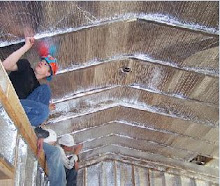 Author: Ed Fritz
Author: Ed FritzOnce you have decided to install radiant barrier, you have to determine which method of installation would suit your home best. Mainly, there are two criteria that should influence your decision: 1) The climatic conditions in your area and 2) Whether your attic has ductwork.
Two of the most common methods by which you can install radiant barrier are either stapling the attic foil to the bottom of your roof rafters or getting the radiant barrier foil insulation spread out over your existing batt or blown-in attic insulation.
In case you reside in a mixed or cold climate, getting the radiant barrier installed across the attic floor insulation is the easiest and most effective. When summer comes, it would reduce radiant heat gain into the home. When it's winter, it will lessen heat loss because of radiation and limit convective looping, which has to do with cold heavy air sinking through the attic insulation and reducing the insulation's R-Value. Don't forget, foil insulation ISN'T a replacement for regular attic insulation. They work in combination, decreasing both conductive as well as radiant heat flow.
If you reside in a warm or hot climate and there ISN'T any ductwork in your attic, then by all means install the radiant barrier attic foil on top of your existing insulation. This happens to be the best option to minimize summer heat gain and winter heat loss. Make sure you have adequate insulation BEFORE you add radiant barrier. After you have laid out the radiant barrier over the blown-in insulation, you can't put more insulation on top. This will take away the advantage you get from your radiant barrier, which requires an air space on one side of the foil to function effectively.
However, if there IS ductwork in the attic, then the staple-up method is preferable. Let's look at it this way - if you put ductwork in your attic, it's similar to making ice cream using the oven. By stapling the foil to the bottom of the rafters, you get the benefit of reducing radiant heat inflow into the attic insulation AS WELL AS bringing down the attic temperature. By keeping the attic temperature down, less heat will be transferred INTO the ductwork due to conductive heat flow. Additionally, it feels extremely cool when you stroll into your attic on a hot summer day and it feels much more comfortable compared to being inside an oven.
Any of the methods of installing radiant barrier works well. Where the climate is hot/warm, it's a question of what's easiest and if you have duct work. When you staple radiant barrier to the base of the roof rafters, you will get a cool attic, put the ductwork in a more favorable environment AND reduce radiant heat gain into your home. The staple-up method results in the minimum overall heat gain into your home. Both of these methods of installing radiant barrier is going to make your home feel more comfy and save you money on your utility bills.
Article Source: http://www.articlesbase.com/home-improvement-articles/what-is-the-best-method-for-installing-a-radiant-barrier-1489271.html
About the Author:
Ed Fritz is the owner of www.AtticFoil.com. His passion is to help homeowners make their homes more comfortable and energy efficient. He has helped literally thousands of customers by sharing his first hand experiences using radiant barrier foil . To learn more about Ed and how radiant barrier foil can help cut your energy bill, visit his blog at The Radiant Barrier Guru .




